Anime and manga have a unique visual language that conveys character emotions and thoughts. Many of us “regular” anime watchers are so familiar with these symbols that we don’t give them a second thought. These symbols (like the vein popping out, as shown to the left) can make anime confusing for people new to anime. I found my first experience with chibi swaps jarring and uncomfortable. Some symbols are easier to understand than others. We will cover the most common and incomprehensible symbols in this article.
Easily Understandable
- Speed lines
- Abstract Background Patterns
- Eye symbols
- Crying large tear drops
- Sparking a rivalry
What happened?
- Popping vein
- Sweat Drop
- Cat Mouth/Fangs
- Nose balloon
- Ghost coming out of mouth
What the….?
- Bleeding nose
- Falling flat
- Colored lines dropping over character
- Chibi deformation
These and other symbols appear in various degrees in anime and manga. Some genres, such as comedies and “slice of life” stories, show them more often than others . Action and drama occasionally use these symbols for comic relief, for example Bleach or Death Note.
Speed Lines
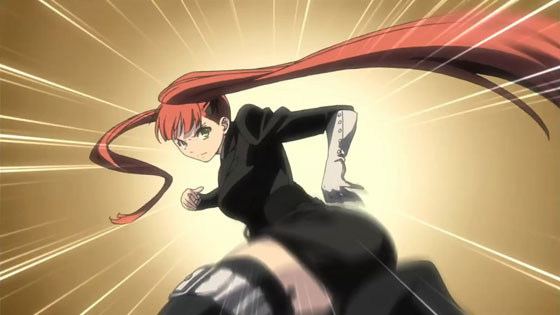
Speed lines are lines that appear in the background or over a character to denote speed. Speed lines are more common in older anime than in modern anime. Speed lines are used to keep the feel of reading a manga or simply keep the animation budget down. In modern anime, where action is expected to be crisply animated, speed lines are used for comedic effect or to accent an intense action sequence.Speed lines are common in American comics as well. They are simply a good way to convey motion in a motionless media.
Abstract Background Patterns

Sometimes in scenes the background abruptly switches to an abstract background. This swap is used to emphasize what the character is feeling. Often the background is composed of symbols from our list above. Swirls are used when a character is confused or overwhelmed. Speed lines are used to show the character’s energetic mood. Backgrounds vary based on context. Most of the time, they are easily understandable.
Sometimes these backgrounds are animated to further show what the characters are thinking or feeling. Fast animations or twirling spirals show how quickly the character’s mind is working, much like gears in a clock. Wavy lines show irritation or upset emotions. Colors such as bright red are used for anger. Darker colors like purples or blues are used to show the characters are feeling sick, upset, or depressed. Background swaps are usually abrupt.
Eye Symbols
The eyes in manga and anime are used to convey a wide range of thoughts and emotions. Eyes have gotten larger since the 80’s and allow artists to show emotions clearly…if you know the icongraphy. Most tend to be obvious from reality. People’s eyes lift up into arcs when they are happy and fall downward when sad. Pupils constrict and eyes widen when we are scared. In anime these subtle queues are exaggerated. The slight upward or downward arc becomes a complete arc. Constricted pupils and widened eyes become enormous eyes with tiny dots for pupils. Some symbols are not so obvious, however. X’ed eyes or spiral eyes are used to show dread, illness, and confusion. Sometimes the eyes completely disappear when a character bows their head in sadness or depression. The eyes are replaced with vertical lines and blue or purple colors to show depression or sadness. Eyes with sparkles and white dots are cute. Often they are flashed to help a character get their way. Think Puss-in-Boots from Shrek.
Many of the eye symbols in anime have made it online as emoticons:
- ^_^ very happy.
- -_- apathetic or irritated
- O_O afraid. very awake, surprised
- O_o confused and mildly disturbed by something
- @_@ confused, dizzy or overwhelmed – in anime these are spirals
- X_X dead figuratively or literally
Crying Large Teardrops
This one is pretty self explanatory. Waterfalls of tears shows how upset a character is. Most of the time it is used for comedy. Normal sized tears are more common in dramas and more serious scenes.
Sparking a rivalry
This one is pretty easy to understand as well. Anime and manga just takes the phrase literally. Two characters glare at each other and a spark passes between then. Soon after they fight. This is usually used when 2 characters first start their rivalry. This is common in shows like Pokemon and Yugioh.
The Strange
The next set of symbols are a little stranger for people new to anime and manga. They are not as easy to understand as speed lines and eye symbols. Like eye symbols, these symbols are iconic to anime. Anime’s icongraphy ( as it is called) nicely conveys emotion and thoughts… but only if it is well understood. To those of us used to them, they seem natural. It is easy to forget that anime is extremely exaggerated compared to most other art styles.. Most symbols are visually showing phrases we say such as “wound up” or “forked tongue.”
Popping vein
Technically speaking this symbol is called a cruciform popping vein. Like other symbols it is exaggerating reality. When some people are irritated or angry veins tend to pop out as their blood pressure increases. Often on their forehead and hands. As more popping veins…pop out… on a character, they are growing more and more irritated or angry. Most often these symbols show up on the heads of characters ( over their hair etc) and on clenched fists. Rocking cruciform veins show winding irritation or anger. These characters are “wound up” as we like to say in America.
Sweat Drop
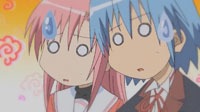
This is another iconic symbol. It means the character is anxious or confused. The number and size of the sweat drops shows the degree of the emotion. Sometimes these are used with a blush across the character’s face to show embarrassment. Blush colors determine what type of embarrassment is being experienced. Blue blushes are severe embarrassment mixed with anger or depression. Red blushes are romantic embarrassment. Both blushes and sweat drops can be occupied with a popping vein if the character is feeling angry embarrassment. When combined with shocked eyes, like the example image, it shows how the character feels stunned and/or confused about the situation. Perhaps its best described as an “What is this?” moment. Sweat drops appear in the same locations as popping veins.
Cat Mouth/Fangs
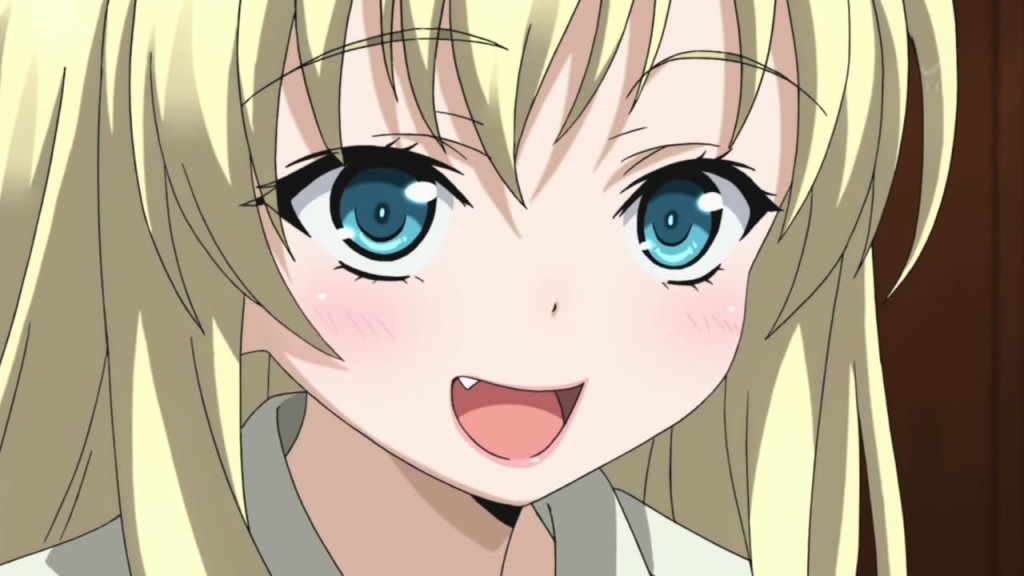
This is one of the odder ones. Abruptly characters (usually female) swap in a cat mouth or grow fangs. This swap doesn’t mean the character is a cat demon or a vampire. Rather, she is feeling “catty.” This is yet another literal visual interpretation of a common phrase. Cat fangs or mouths just show the character is feeling mischievous.
Nose Balloon
Nose balloons are the Japanese ZZzzzzZZz symbol. The character is sleeping. When the balloon pops, the character wakes up. I am not exactly sure where they got this symbol, other than a snot bubble.
Ghost coming out of mouth
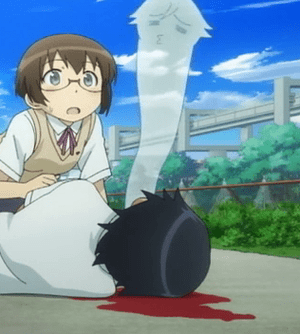
This is a play on the saying “scared to death.” This symbol often looks sort of like the character it belongs to. The ghost usually appears when someone is extremely shocked or horrified. The character isn’t usually actually scared. More like shocked to death. These scenes can involve someone trying to stuff the soul back into the body for further comedy.
Finally, these symbols are the most jarring and difficult to understand at first. They involve drastic (very drastic) changes to the look and feel of the anime or manga before jarring the viewer back to the more “normal” style. These abrupt switches can leave new viewers lost, but each has specific purposes in conveying situations and emotions.
Bleeding nose
Anime characters seem to just spout blood from their noses at random times to have the blood disappear like it never existed. These nose bleeds can easily kill a normal mortal. Nose bleeds are one of the more obscure symbols. They represent perverseness or sexual arousal. As to why anime and manga artists selected nose bleeds is a matter of opinion. Censorship may play a role. Or their mothers always told them, “if you have dirty thoughts you will get a bloody nose.” Just like your mother told you that “if you don’t behave you will get nothing but a lump of coal for Christmas.”
Falling Flat
Japan is known for having earthquakes, but that isn’t what is happening when characters randomly fall on their face. Falling flat is a way to show irony or a reaction to a (bad) pun. I have felt that way about some jokes and puns I have heard.
Colored Lines dropping over character/Color Face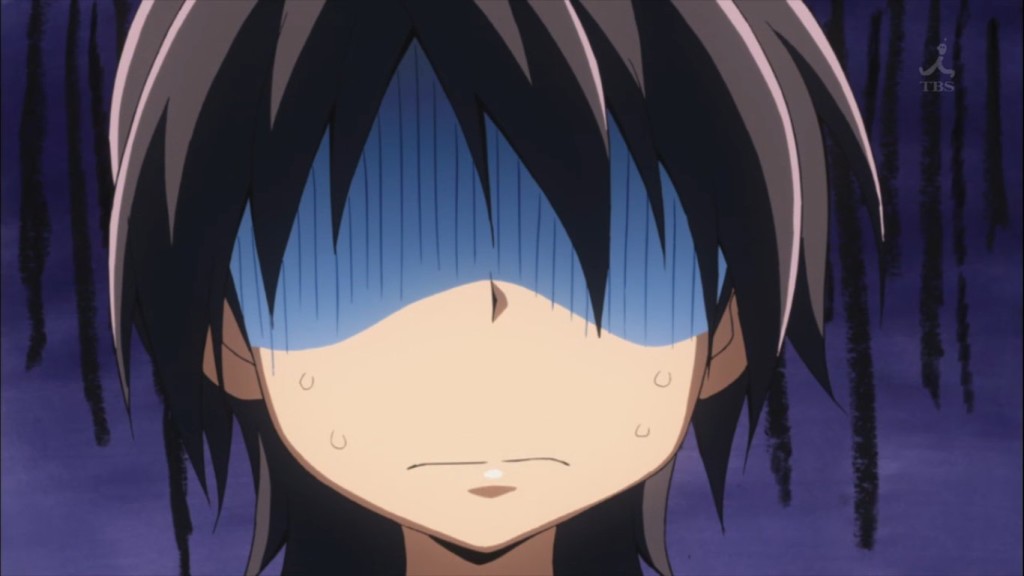
This symbol is very situational. Similar to backgrounds these lines and color fills represent the thoughts and emotions the character is feeling. Red vertical lines typically mean anger or embarrassment. Blue wavy lines shows awkwardness, depression, or sadness. Purple shows shock and feeling sick in the stomach. Horizontal lines can mean the character’s attention is grabbed by something. These lines are accompanied by sweat drops, popping veins, and other symbols. They are rarely used alone. Their main purpose is to emphasize the other symbols.
Chibi deformation
This is the most troubling of symbols for new viewers. The style change is so drastic it makes you wonder if you accidentally sat on the tv remote! These short, round and cute versions of characters are called chibis. They are used to convey a comedy break in an otherwise serious story, a very ironic situations, and just generally lighthearted scenes. Some comedy anime are done entirely in the chibi style. They are meant to look like dolls or children to lend silliness to a scene or storyline. Chibis are just fun.
There are other symbols in anime such as people sneezing when they are being talked about by others. In America we say our “ears are burning.” A small white mushroom shaped cloud is exhaled when a character is relieved about something, and there are many more. Anime’s visual language is what sets it apart from other animation styles. The symbols give anime its charm. At first they come off as just plain weird, but over time and repeated exposure the symbols feel natural. They clearly show what characters are feeling and thinking. A single sweat drop is better than a verbal explanation. Anime is already (in) famous for characters explaining their actions and shouting the names of their attacks. “Wind SCAR!” “Over NINE-THOUSAND !” Like they’ll never see that attack coming…
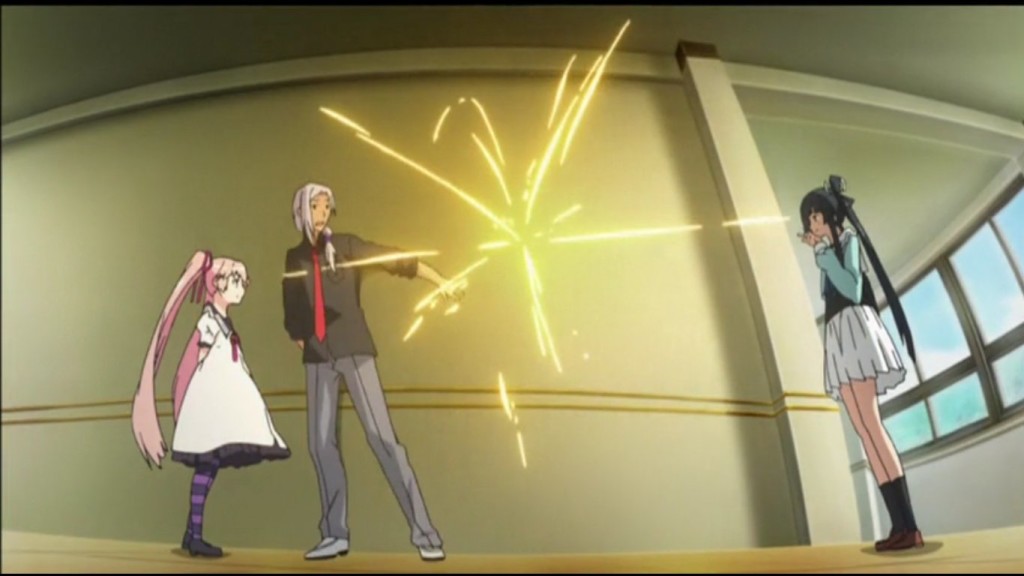
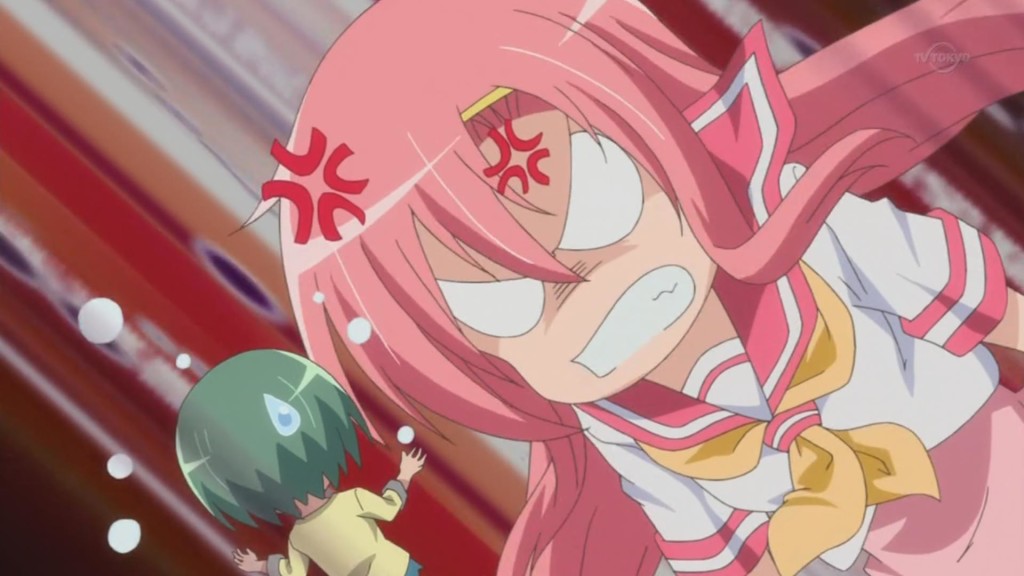

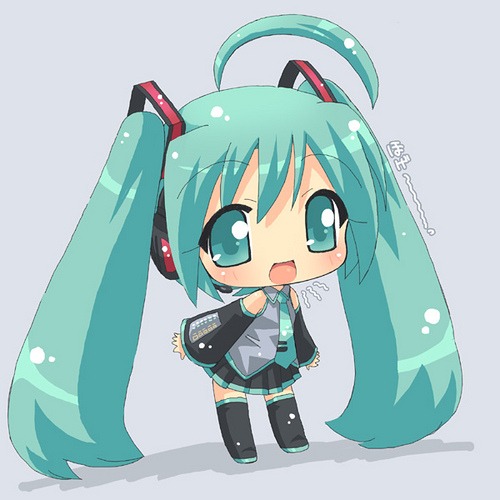

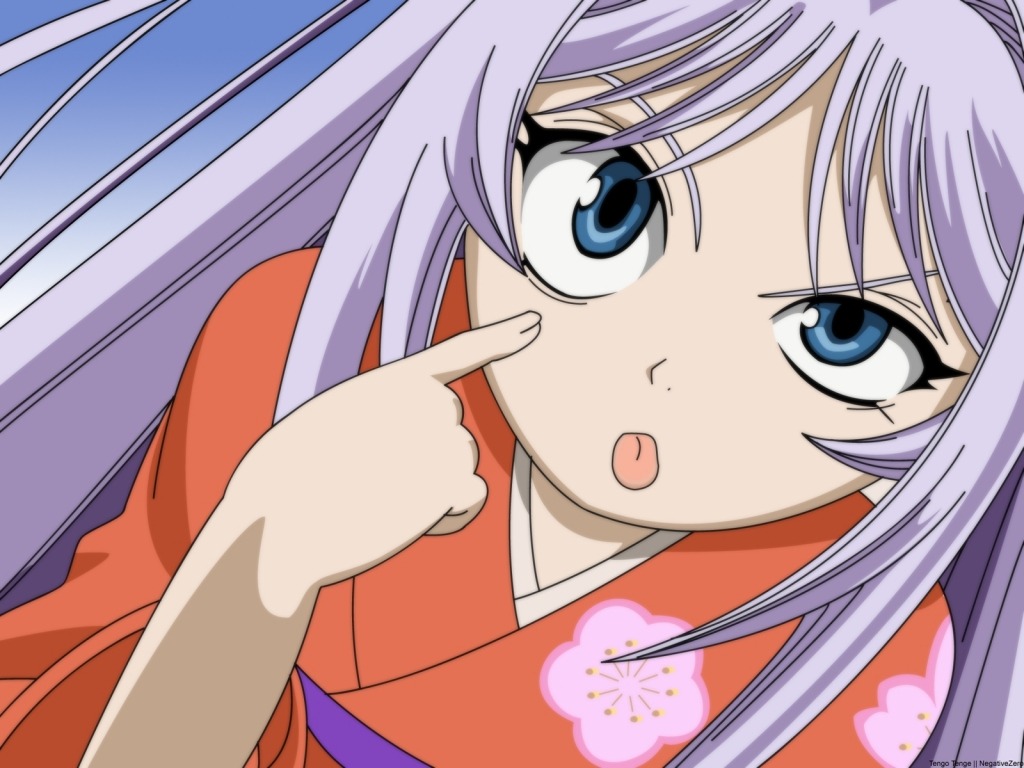
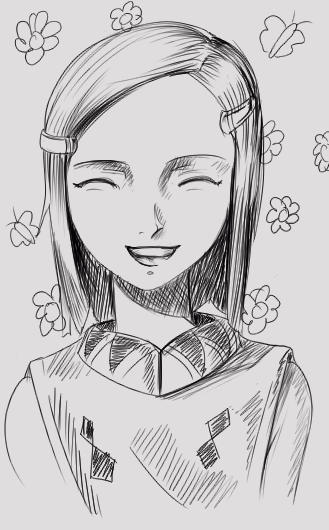
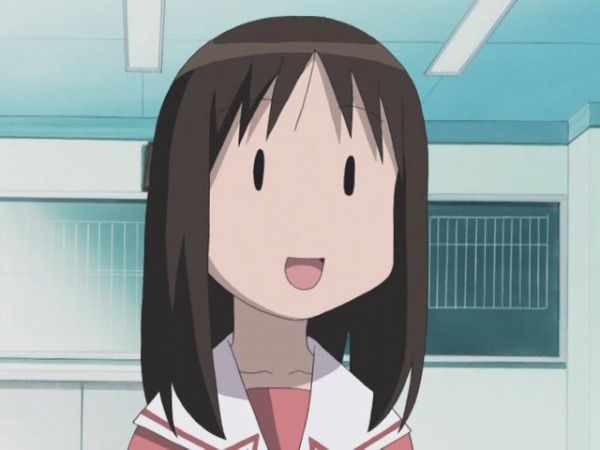
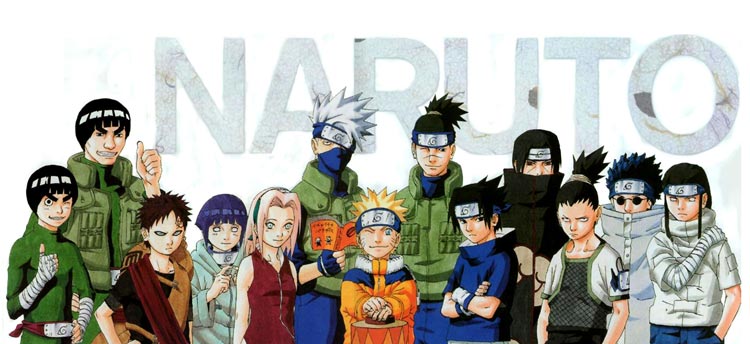
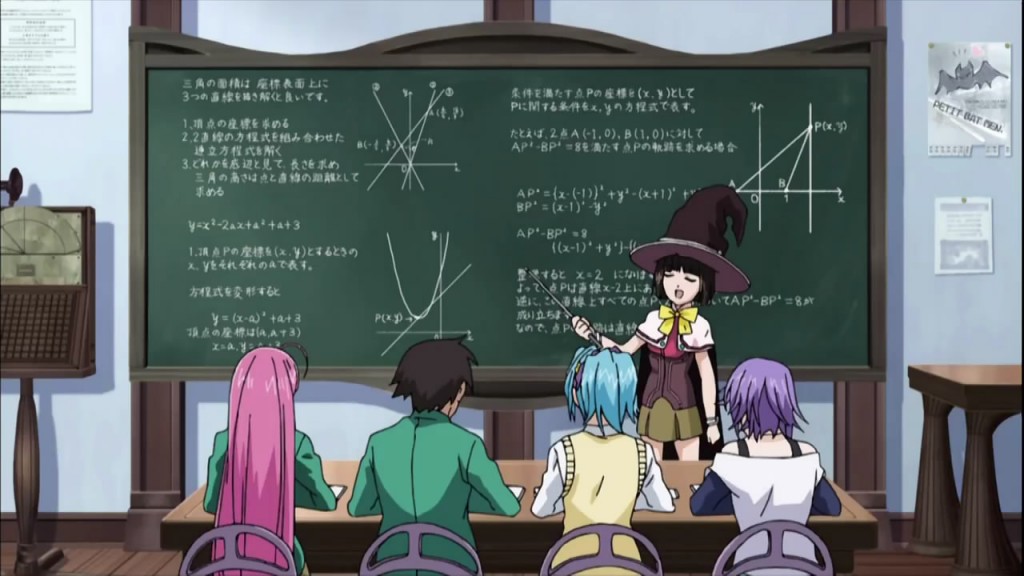
That fits as well as any other way to describe it. I just figured it was some technique used by anime artist and writers, to be a bit risqué and cheeky at the same time. Thanks for the response.
In anime I have noticed that when a character is about to display a significant sexual body part; the body part is covered up in a comedic manner by another object (i.e. another characters hand, a bush, a piece of food, etc…). Is there a name for that technique?
I haven’t heard of a specific name for that technique. Comedic foreshadowing might be the best phrase for it.
My experience with Anime and the switching to chibi is the person is acting childish, but I’ve also seen some used when explaining things.
I’ve also seen chibi used to explain different concepts. It’s curious how the teacher takes on a childish design, perhaps to help the audience avoid feeling “talked down to”.
very clear and good article easy to understand. Thank you
The bloody nose is caused by a sudden rush of blood to the head when an extremely lewd situation occurs. It’s like the blood rush is so sudden and overwhelming that the only way of escape is through the nose.
That is a good explanation too!
Sasuke Uchiha is the best anime character Every one should know that.
oops, yea.. more on ‘nose baloons’ if looks like a mini speech bubble, that’s a snot bubble.
“Nose Balloon”
lol, that’s their spirit, lol
You are right. I just had to find a neutral way of labeling it for those new to anime.
Watching Kenichi the Mightiest Disciple and notice sometimes a small white rabbit marching, running, or walking in the background when he gets hurt. Sometimes the rabbit has a small branch or flag. I still cand figure this out. Thanks!
I’m not familiar with Kenichi, nor am I aware of the rabbit appearing as a trope. Some references are set within the context of the story or the author’s other work. A rabbit can reference the moon. Japanese folklore sees the Western “man in the moon” as a rabbit in the moon. But I don’t believe a martial arts comedy will reference this folk belief. Sorry, I’m not able to offer more information!
How are those scenes with the abstract background patterns called in japanese? Most of the times those are used as a imaginary scene a character is creating in their head, but also when a character is way too handsome to appear like a regular character, right? I’ve been searching for a while and can’t find it anywhere the answer… Thanks in advance!
Unfortunately, I’m not aware of a name for the background patterns and academic literature just calls them background patterns or, rarely, flourishes.
I remember when I was first getting into anime, I had watched RWBY(It’s an American anime and it was kind of my transitional phase to get used to anime. I have long since transitioned into actual anime and I love it but RWBY is also amazing, if you haven’t watched it already please do. The animation is worse than most shows but don’t let that deter you because it has literally the best fight scenes I have ever seen. The world is very colorful and the outfits are amazing, the music is like nothing else. It always holds a special place in my heart. When I was 5, I watched Avater: The Last Airbender as well, but I hadn’t realized it was an entirely different genre of show that I had never watched before. If I had realized there were other shows like Avatar, I would have gotten into anime sooner.) and then a friend of mine had recommended Naruto to me. But if you recall in the first couple episodes, there were a fair amount of pervert/sexy jutsu jokes with nose bleeding that was way too much for 13 year old me. Since I was new to anime and I had never seen the nose bleed effect before, I found the nose bleed really sickening(they also overdid the nose bleed a lot, like they were gushing rivers of blood from their nose and I was kind of traumatized XD). Even though I could figure out what the nose bleed meant, it didn’t help. Also, some of the fight scenes that I had seen were pretty bloody as well. People were constantly getting wounded and when they did blood would gush out and it was very graphic. I just couldn’t get into Naruto after that and I’m still reluctant to because Naruto is one of the gore-y-er animes. It’s kind of the same reason I never watch horror movies. I have found many animes I enjoy though, like the Fate series, Fairy Tail, Assassination Classroom, Sword Art Online, Princess Mononoke, Somali and the Forest Spirit, etc.
Yes, Naruto starts out rather obnoxiously. Anime and manga likes to use this trope to show how the character matures over the course of the story. But it can be annoying. If Naruto’s blood troubles you, you will have to be selective and avoid titles like Hellsing Ultimate (which is quite brutal) and perhaps even Samurai Champloo.
Is there another name for the visual when an anime character becomes angry and a shadow that covers their eyes appear?
I don’t know of a specific term for it. Perhaps “shadowed face” would work best?
I have a question and I’ve been trying to find what they’re called and what they mean exactly.
It’s the little floating fires that surround a character that generally appears with a feeling of gloom. I saw them shown up a few times while I was reading the FMA manga.
Unfortunately, I’m not aware of a specific name for that emotion. But it is similar to “Colored Lines dropping over character/Color Face” to denote depression and melancholy. It tends to also have a feeling of tiredness if I remember correctly.
Those blue flames are symbolic of dark spirits (known as “onibi”) — which are, in turn, symbolic of the dark thoughts the character is having.
Onibi (which translates to “ghost fire/flame) are lost spirits, without direction, who have (usually) met an unfortunate demise.
I’m not sure if previous messages were sent from this email or another but disregard previous sent messages sorry for the trouble
I didn’t receive any messages previous. Did you have a question?
Bleeding nose represents the blood rush to the head when getting overly excited. High blood pressure.
A good observation. It is usually isolated to sexual contexts.
So Chibi is what its called, nice to know.
Though the thing is, I find its use in anime for comedic moments or “huh?” moments.
And during these moments the character goes through a bit of Chibi but the character goes through a drastic decrease in facial and physcial quality to acknowledge non-seriousness.
Yes, chibi is used for comedic moments. You can also see it used for perverted-old-man characters.
Sometimes a chibi is used for a simpler and cheaper animation style. They use this for explanation bits to an anime. (Like explaining powers, or family tree)
Good observation! I’ve also seen chibis for such scenes.
It’s also used to simply work for the animators.
Anime uses a lot to tricks to lessen the amount of animation required. Often times, this is so they can focus time on more work heavy, intense scenes.
*simplify
It simplifies their work.
any references about anime facial expressions??
This article and my examination of anime’s facial expressions come from my observations. The “Master Guide for Drawing Manga” by Christopher Hart is a good introduction to expressions. Perhaps the best way to draw expressions is to select a few of your favorite anime or manga and draw frames from them.
Great article! I’ve been needing exactly this kind of information to start my new webcomic.
Best of luck with the webcomic!
Is there a name for these expression or style?
Not that I am aware of. Most people call it manga or anime style or perhaps Japanese animation.
I’d like to know what to search and look out for by knowing the name of this, but I’m still unsure of it.
Where the chrachters have a shaded face, the eyes don’t show, straight face. Emotionless/sad mind kind of look
This “hidden eyes” expression doesn’t really have a name that I’m aware of despite being a part of manpu. The shaded face can have different meanings based on context and coloration, from depression to just a brain freeze from eating ice cream too fast.
Sorry I couldn’t be of much help. 🙁
what about times when (mainly just male characters) no eyes or lines are shown whatsoever, just missing entirely (or sometimes covered by hair bangs? a friend told me it represents being entirely emotionless/evil, cold. what say you?
Your friend is right. Most of the time such scenes show coldness and distance. But it can also mean the character is hiding something, usually their feelings. Some character designs use this to suggest the character is shy too. It depends on context.
Do you happen to know what a flower appearing on top of the head means? I’ve seen it (mostly in mangas) that a flower appears during certain situations on top of the head of the character that no other character acknowledges. (If they do is usually a break on the fourth wall).
For what I gather, it seems to represent the “air-headness” or obliviousness of the character with the flower. But I’m not sure. Could you help me?
Some visual language is unique to a particular author and series. However, flowers are associated with certain emotions thanks to what is called hanakotoba, or the language of flowers. For example, an anemone is associated with the feeling and state of being forsaken. It could be the manga is pulling from hanakotoba to show what a character is feeling.
Thanks for this, I just had about 30 frustrating minutes trying to figure out how to google what eventually turns out to be “chibi”. More and more western comic artists are using it in their work, but only in the comedy strips. Now I know what it’s called.
I’m glad I could help. Anime and otaku culture has its own lexicon that can be hard to tease out. It’s interesting how chibi and other manga elements are becoming common in Western comics.
Any academic articles on this topic? Thanks in advance!
The article consists of my observations, but for an academic look on visual language you can try:
Alshenqeeti, H. (2016). Are Emojis Creating a New or Old Visual Language for New Generations? A Socio-Semiotic Study. Advances In Language And Literary Studies, 7(6), 56-69.
Broek, J. d. (2012). Visual language : perspectives for both makers and users. Hague : Eleven International Pub. ; Porland, OR : Distributed in USA by International Specialized Book Services, c2012.
Erwig, M., Smeltzer, K., & Xiangyu, W. (2017). What is a visual language?. Journal Of Visual Languages And Computing, 389-17. doi:10.1016/j.jvlc.2016.10.005
yo, is there any sort of all encompassing term for these effects? like onomatopoeia but for emotions?
You could call these a form of gitaigo, which are emotional onomatopoeia as the article about manga sound effects discusses. There are enough similarities that the line between words and images doesn’t really exist. Often, gitaigo combines with various visual language words to complete the emotion a character is feeling.
what does the hand blocking sun/moon/light mean ??? its been bothering me the last couple of days cause i realized i’ve seen it in almost every anime
It depends on context, but I understand it as an effort to hang onto a fleeting moment. In most cases a character reaches for the sun or moon, they are thinking about an important present moment or a moment from the past. It’s a pause to consider feelings and sometimes affirm existence. The hand blocks out the light, an affirmation that the character exists in the present moment. I consider it a reference to Buddhism’s focus on being aware of the present and the sensations of that moment. Of course, sometimes too the light is simply blinding them and there isn’t any symbolism : ).
Lol u are all wrong and so am I
someone can tell me the anime from the redhaired girl ? ( First Image )
And The Second one plz ;-;
The red-haired girl is Felicita from La storia della Arcana Famiglia.
The second image is from Fullmetal Alchemist.
What does a cow lick represent?
Cowlicks are often used for extra characterization. They help show how the character is feeling. For example, a cowlick at attention means the character is surprised or paying attention. Drooping cowlicks suggest sadness or shame. Swirling cowlicks: confusion. Wavy cowlicks: happiness or excitement.
Rikka Takanashi makes a good example of this type of characterization.
Excellent answer. Thank you.
The cow-lick used to be used exclusively for “clueless” characters (representing a perpetual question mark over their head). As time went on, it made its way into various other type characters, but often still represents some naivety, unworldliness, or innocence.
I enjoy how the “antenna” can be used for all sorts of expressions and emotions too.
OK what does the sideways P eyes mean in anime.
Those eyes represent annoyance and sometimes bored annoyance. The lack of pupils shows a lack of attention.
And what’s the meaning of this simbol?
https://pm1.narvii.com/7200/f2fb97734f1062112d7646edcd366510a2025098r1-2048-1536v2_hq.jpg
That symbol is meant to show activity, gestures, and chatter. It isn’t a standard symbol in anime visual language.
Okay, then what do plus signs mean? In the Tales franchise, certain skits have plus signs in a thought bubble of some kind. This I don’t understand clearly.
I am not familiar with the most recent Tales games. I have played Tales of Symphonia and the first Super Nintendo game. Do you have any samples? The Tales series uses their own emoticons, and it is hard to judge them without seeing them.
I don’t have any samples, but if you watch youtube videos based on just the skits from the games, you may notice the plus signs in some of them. There are a few skits that have these plus signs in Tales of Symphonia: Dawn of the New World and in Tales of Vesperia. I’m thinking since rewatching them, that they may mean happiness to some degree. There may be spoilers too.
After watching the skit, it looks like the sign means bubbly laughter or happiness.
Ok what about random background chibi monsters that don’t do anything but randomly appear continuously throughout a series, notable in fairy tail and other anime
Some are likely for comedic effect. I haven’t watched Fairy Tail yet. Some critters are folklore references too. Others are also to just add to the chaos :).
What does the appeearance of a rabbit convey?
If a character turns into a rabbit it is usually for comedy or to make the character look mischievously cute. It depends on the anime.
There is a story that a rabbit offered itself to the Buddha for food when the Buddha was very hungry. The Buddha, as thanks for the rabbit’s selfless view, placed the rabbit in the moon instead of eating it. The face on the moon is a rabbit rather than a person’s to many in the East.